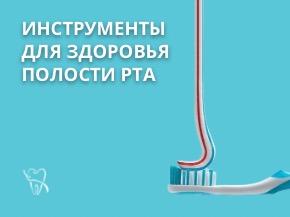For comprehensive dental and gum care, it is not enough to limit yourself to a standard set in the form of a brush, paste and floss. There are specialized devices that provide thorough cleaning of areas that are inaccessible to conventional means, as well as orthodontic structures, prostheses and the surface of the tongue. This category includes:
1. Monopuckle toothbrushes.
2. Spatulas (scrapers) to remove plaque from the tongue.
3. Irrigators (hydroflosses).
4. Antiseptic rinses and cleansing foams.
5. Therapeutic and preventive chewing gums.
Monopuckle brushes
Their design feature is a compact head with a single bundle of bristles. This allows you to purposefully and effectively clean the neck areas of teeth, the retromolar space (the area of wisdom teeth), as well as other complex areas. This type of brush is especially important for people wearing braces or dental implants, as well as for crowded dentition.
Cleaning the surface of the tongue
Proper oral hygiene involves more than just dental care. The tongue, especially its back, serves as a place of active accumulation of bacterial plaque. This mass not only contributes to the appearance of caries, but also often becomes the main cause of halitosis, a persistent unpleasant odor. The systematic use of a special scraper, alone or together with an antibacterial gel, minimizes the risk of diseases such as gingivitis, stomatitis and periodontitis.
Application of the irrigator
This device generates a pulsating jet of water or a therapeutic solution, which, under pressure, cleans food residues from the interdental spaces, areas around crowns, bridges and braces. Despite its high efficiency in removing fresh plaque and massaging gums, the irrigator is not able to completely remove the resistant biofilm. Therefore, it serves as a complement, rather than a substitute for mechanical cleaning of the interdental spaces using dental floss or brushes.
Mouthwashers and foams
The composition of these funds determines their effect: they can have anti-carious (due to fluorides) or antibacterial and anti-inflammatory effects. The standard rinsing procedure takes about 30 seconds using 10-20 ml of solution. Foams enriched with enzymes act as a convenient solution for express cleaning of enamel after a snack on the road or at work, when using a brush is impossible.
The role of chewing gums
Their use is justified as a temporary hygiene measure after eating in the absence of an opportunity to brush your teeth. The chewing process promotes the mechanical removal of food particles, neutralizes acids produced by microorganisms, and activates saliva production. The key selection criterion is the presence of xylitol in the composition, a sweetener that suppresses the activity of cariogenic bacteria and helps restore the physiological pH in the oral cavity. It is recommended to chew gum for no longer than 10-15 minutes.
Dentist-general practitioner of the dental department No. 1 – Anastasia Vitalievna Shekh



